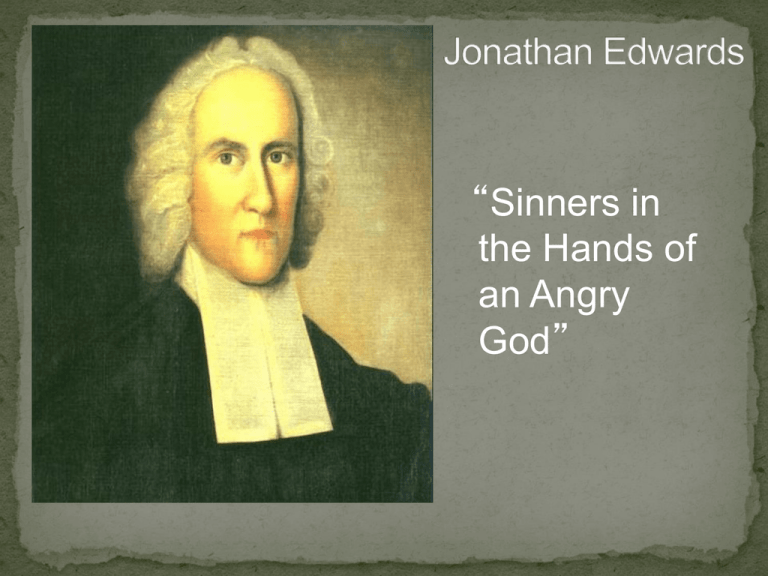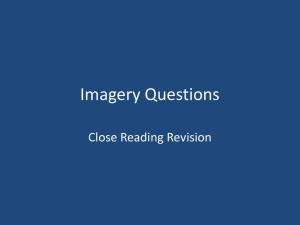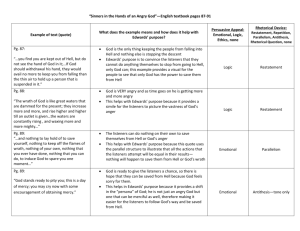Sinners in the Hands of an Angry God: Analysis
advertisement

“Sinners in the Hands of an Angry God” For Edwards, science, reason, and observation of the universe confirmed for him the existence of God. A brilliant thinker and speaker, Edwards entered Yale at 13 and became a minister 12 years later. His passionate, yet frightening, sermons helped to bring about The Great Awakening, a time when many who attended church were not “saved” or could testify to an emotional encounter with God and His grace. “Unregenerate” Christians were those who attended church and accepted church teachings but had not been “born again” by God’s grace. He was dismissed as pastor in 1750 because his sermons were too extreme; he “called out” those in the congregation who were leading lives “relapsing into sin.” Ironically, Edwards died of a smallpox vaccination, a modern medical procedure many Puritans considered sinful. Writers often create vivid experiences for their readers by using imagery, language that appeals to the senses. Imagery describes tastes sounds sights textures smells The combination of these senses creates a dramatic and vibrant world. In his sermon, Edwards uses terrifying imagery. “The devil is waiting for them , hell is gaping for them, the flames gather and flash about them, and would fain lay hold on them, and swallow them up. . . .” He wants his listeners to experience the horrors he believes they will encounter if they do not repent of their sins and obey God’s laws. Imagery Personification Personification Metaphor Simile Simile metaphor Imagery Simile Simile Imagery/ metaphor Simile Simile Simile Simile Simile metaphor In addition to imagery, Edwards also uses repetition to emphasize his points. As you read, record images and words that Edwards uses repeatedly, such as wrath and descriptions of “the pit of hell.” “. . . are actually suffering the fierceness of His wrath in hell. . . .” “. . . held in the hand of God, over the pit of hell; they have deserved the fiery pit, and are already sentenced to it. . . .” Consider how repetition might affect a listener and how it contributes to Edwards’s purpose. • The author’s purpose is the reason that he or she is writing. • Authors may write to inform, to persuade, or to entertain. • Sometimes they state their purpose directly. • Other times, readers determine an author’s purpose by paying close attention to the details and images in the selection. • As you read, think about how and why Edwards uses certain images, and monitor your reactions to them. • Consider what reactions Edwards might want to elicit from his readers. From the text: “O Sinner! Consider the fearful danger you are in: It is a great furnace of wrath, a wide and bottomless pit, full of the fire of wrath . . .” Imagery & Metaphor In this fire-and-brimstone sermon, Edwards uses the metaphor of fire & the imagery associated with it to link his listeners’ experience of fire to the idea of burning in the fires of Hell because of their sins. Use a chart like the one on the next slide to record Edwards’s images and explore how they help him to achieve his purpose. In the first column of your chart, record Edwards’s images. In the second column, explore how they help him achieve his purpose by explaining how and why it is used. Finally, in the third column record your reaction or the reaction you would expect his audience to have to Edwards’s use of imagery. Imagery & Author’s Purpose Chart Image How/Why It’s Used Reaction “the flames gather and to show what will happen I find the image frightening. flash about them. . . .” to “natural men” Option A: Locate three statements from the sermon that when taken together provide an accurate summary. “That world of misery, that lake of burning brimstone, is extended abroad under you.” “Thus all you that never passed under a great change of heart . . . are in the hands of an angry God.” “Consider the fearful danger you are in.” Option B: Write three statements of your own that summarize the main idea of the selection. • Edwards’s convictions put him at odds with society. • Would you risk being an outsider for your beliefs? • Why or why not? • What beliefs of yours do you consider most important? • Do you think it is necessary to persuade others to share those beliefs? • Why or why not? Imagery & Author’s Purpose Chart Image fire pent up in their own hearts is struggling to get out How/Why It’s Used to show the inherently evil nature of humans and people’s lack of control over their behavior Reaction That’s overwhelming pressure. fear hell’s wide gaping mouth instillQuestion Discussion open Temptation seems ever #4: present and unavoidable. Author’s Overall Purpose = nothing between you and Mortals are so fragile to show need for God’s and can choose to people hell but the air God is all-powerful intervention and how ephemeral it’s a wonder the natural at all.if send humans to world the isfiery bowelssurvive of hell if God should withdraw His God, not our own efforts, support I must trust God to hold he so chooses. Humans are fragile and hand us me up. torestraint stopand God’sI anger wrath of God is likecan greatdotonothing show God’s don’t want to incur the waters that are dammed power force of God’s wrath. except to be reborn. for the present a spider’s web would be unable to stop a fallen rock as an analogy to a person’s own efforts Christ has thrown the People who ask God to save doors of mercy wide open. them will be saved. Strength comes from God not from my inner self. I want to be one of the chosen. • Edwards’s beliefs motivate him to try to change the lives of others. • Do you think this desire is common among people with strong beliefs? Why or why not? • Edwards’s use of repeated words and images helps convey his message by arousing fear in his listeners. • Do you see his approach as effective? Explain why or why not, giving examples from the text. • How would you try to convince someone to change his or her behavior? What words and images would you use make your plea dramatic?









